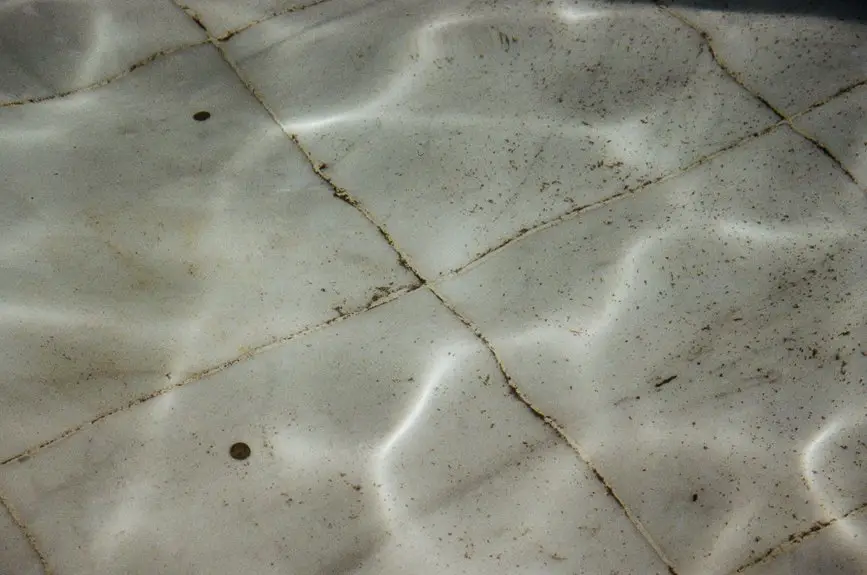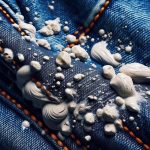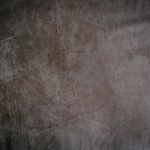To remove mud stains from upholstery the right way, first identify your fabric type to pick a safe cleaner. Gently scrape off excess mud, then blot fresh stains with a damp cloth—avoid rubbing to protect fibers. For dried mud, vacuum loose dirt before spot cleaning with a mild solution. Always air dry thoroughly, repeating only if needed. Using the right tools and methods prevents damage and keeps your upholstery fresh. Keep going to discover effective cleaning tips and long-term care strategies.
Table of Contents
Key Takeaways
- Identify your upholstery fabric type and check care labels before choosing a suitable, pH-balanced cleaner for mud stain removal.
- Quickly scrape off fresh mud gently, blot with a damp cloth, and use mild detergent solution without rubbing to lift stains.
- For dried mud, scrape loose particles, vacuum debris, and spot clean with upholstery cleaner, blotting from outside in.
- Always test cleaning solutions on a hidden spot first, blot stains gently, and let upholstery air dry completely after cleaning.
- Use protective sprays, vacuum regularly, and address spills promptly to prevent and manage future mud stains effectively.
Assessing the Type of Upholstery Fabric
Before you tackle mud stains, you need to identify your upholstery fabric. Different materials react differently to cleaning methods, so knowing what you’re dealing with is essential.
Check the manufacturer’s tag for fabric type and care instructions. If there’s no tag, test a hidden spot by dabbing water to see if it absorbs or causes discoloration.
Natural fabrics like cotton and linen are more absorbent and may require gentle cleaning, while synthetic fibers like polyester or nylon are usually more durable.
Delicate fabrics such as silk or velvet need extra caution to avoid damage.
Once you know your fabric type, you can choose the safest and most effective cleaning approach. This step guarantees you won’t worsen the stain or harm your upholstery.
Preparing Your Cleaning Supplies
Before you start cleaning, gather all the essential tools like soft brushes, microfiber cloths, and a gentle upholstery cleaner suited for your fabric.
Make sure to pick a cleaner that won’t damage your upholstery and test it on a small area first.
Don’t forget to wear gloves and protect your clothes to keep yourself safe throughout the process.
Essential Cleaning Tools
Gathering five essential cleaning tools will make tackling mud stains on your upholstery much easier.
First, grab a soft-bristle brush to loosen dried mud gently without damaging the fabric.
Next, have a clean, white cloth or microfiber towel ready for blotting stains and absorbing moisture.
You’ll also need a spray bottle filled with plain water to dampen the area before cleaning.
A small bowl or bucket will help you mix your cleaning solution conveniently.
Finally, keep a vacuum cleaner handy to remove loosened dirt and debris after treating the stain.
With these tools at your disposal, you’ll be well-equipped to clean mud stains effectively and protect your upholstery from further damage.
Choosing Upholstery Cleaner
When you’re ready to tackle those stubborn mud stains, choosing the right upholstery cleaner is essential to avoid damaging your fabric. You want a product that’s effective yet gentle enough to maintain your upholstery’s texture and color.
Start by checking your furniture’s care label for any specific cleaning instructions. Opt for cleaners designed for your fabric type—whether it’s microfiber, leather, or synthetic blends. Avoid harsh chemicals that can cause discoloration or weakening of fibers.
Keep these points in mind when selecting your cleaner:
- pH-balanced formulas prevent fabric damage
- Stain-specific cleaners boost effectiveness
- Non-abrasive ingredients protect delicate fibers
- Quick-drying solutions minimize water exposure
- Eco-friendly options reduce chemical risks
Picking the right cleaner sets you up for a successful stain removal.
Protective Gear Setup
Selecting the right upholstery cleaner sets the stage, but protecting yourself and your surroundings comes next. Before you begin, gather gloves, a mask, and old towels to prevent skin irritation and keep your workspace clean. Ventilate the area well to avoid inhaling fumes. Prepare a small bucket with warm water and your chosen cleaner for easy access.
| Item | Purpose | Tips |
|---|---|---|
| Gloves | Protect skin | Use waterproof, durable ones |
| Mask | Prevent inhaling fumes | Choose a breathable mask |
| Towels | Catch drips and dirt | Use old, absorbent towels |
| Bucket | Hold cleaning solution | Fill with warm water |
| Ventilation | Air circulation | Open windows or use a fan |
This setup guarantees safety and efficiency while tackling mud stains.
Removing Fresh Mud Stains
You can tackle fresh mud stains most effectively by acting quickly before they set. Start by gently scraping off excess mud with a spoon or dull knife, being careful not to spread it.
Act fast on fresh mud stains by gently scraping off excess without spreading it.
Then, blot the stain with a clean, damp cloth to lift moisture without rubbing. Use a mild detergent mixed with water to treat the area, applying it with a soft cloth or sponge. Rinse by blotting with a cloth dampened in plain water, then let the upholstery air dry.
Remember:
- Avoid rubbing to prevent pushing mud deeper.
- Use cold water to stop staining.
- Test cleaning solutions on a hidden spot first.
- Work from the outside edge inward.
- Blot, don’t scrub, to protect fabric fibers.
Treating Dried or Set-in Mud Stains
Although dried mud stains can be tougher to remove, you can still restore your upholstery with the right approach. Start by gently scraping off any loose mud with a dull knife or spoon. Then, vacuum the area to lift remaining particles. Next, spot clean using a damp cloth and upholstery cleaner, working from the outside in to prevent spreading.
| Step | Action |
|---|---|
| 1. Scrape | Remove loose dried mud |
| 2. Vacuum | Lift residual dirt |
| 3. Apply cleaner | Use upholstery-safe cleaner |
| 4. Blot gently | Avoid rubbing to prevent damage |
| 5. Air dry | Let fabric dry completely |
This method helps you tackle set-in stains without damaging your upholstery’s fabric or texture.
Using Homemade Cleaning Solutions Safely
When using homemade cleaning solutions, you’ll want to pick ingredients that are gentle yet effective on your upholstery.
Always test your solution on a hidden spot first to avoid any damage or discoloration.
Applying the cleaner carefully and sparingly helps protect the fabric while removing those stubborn mud stains.
Choosing Safe Ingredients
Selecting just a few safe ingredients can make all the difference in effectively removing mud stains without damaging your upholstery. When you choose what goes into your homemade cleaner, prioritize gentle but effective substances. Avoid harsh chemicals that might weaken fibers or cause discoloration. Instead, stick to these safe ingredients:
- Water: Always your base for dilution and rinsing.
- Mild dish soap: Cuts through grime without aggression.
- White vinegar: Neutralizes odors and breaks down stains.
- Baking soda: Acts as a gentle abrasive and deodorizer.
- Lemon juice: Offers natural bleaching properties but use sparingly.
Testing Solutions First
Before applying any homemade cleaner to your upholstery, you should test it on a small, hidden area first. This step helps you guarantee the solution won’t cause discoloration or damage to the fabric.
Dab a tiny amount of the cleaner onto the spot and let it sit for about 10 to 15 minutes. Afterward, check for any changes in color, texture, or overall appearance. If the fabric looks normal and unaffected, it’s safe to proceed with cleaning the visible mud stains.
If you notice any adverse effects, adjust your solution or try a different one. Testing first protects your upholstery and saves you from unexpected damage, so never skip this vital safety step when using homemade cleaning solutions.
Proper Application Techniques
Apply homemade cleaning solutions carefully to avoid spreading mud stains or damaging your upholstery. Start by blotting the stain gently with a clean cloth to lift excess mud.
Use a spray bottle or a damp cloth to apply the cleaning solution sparingly, focusing on the stained area. Avoid soaking the fabric, which can cause water marks or mildew. Work from the outside of the stain inward to prevent it from spreading. After treating the stain, blot the area with a dry cloth to absorb moisture.
- Use gentle, circular motions instead of scrubbing vigorously
- Test solution temperature; lukewarm works best
- Change cloths frequently to avoid reapplying mud
- Allow the upholstery to air dry completely
- Repeat treatment only if necessary, avoiding overuse
Preventing Future Mud Stains on Upholstery
Although accidents happen, you can greatly reduce the chances of mud stains by treating your upholstery with protective sprays and establishing simple habits like removing shoes before sitting down.
Applying a fabric protector creates a barrier that repels moisture and dirt, making cleanup easier if mud gets on your furniture. Additionally, encourage family members and guests to wipe their feet or remove shoes before sitting.
Placing washable slipcovers or throws on high-traffic areas adds an extra layer of defense. Regularly vacuum your upholstery to prevent dirt buildup, which can make stains more stubborn.
Frequently Asked Questions
Can Professional Cleaning Services Guarantee Mud Stain Removal?
You can’t always expect professional cleaning services to guarantee mud stain removal since results depend on fabric type and stain severity. However, they use expert techniques that give you the best chance to restore your upholstery effectively.
How Long Should Upholstery Dry After Cleaning Mud Stains?
You should let your upholstery dry for at least 6 to 12 hours after cleaning mud stains. Make sure it’s in a well-ventilated area to speed up drying and prevent any lingering odors or mold growth.
Are There Specific Upholstery Fabrics to Avoid Cleaning at Home?
You should avoid cleaning delicate fabrics like silk, velvet, and antique upholstery at home. These materials require professional care to prevent damage, so it’s best not to risk DIY cleaning on them.
Can Mud Stains Cause Permanent Damage to Upholstery Fibers?
Yes, mud stains can cause permanent damage if left untreated. You’ll find that dried mud can weaken fibers and cause discoloration, so it’s important you clean stains promptly to keep your upholstery looking its best.
What Are the Best Tools to Use for Stubborn Mud Stains?
You’ll want a soft-bristled brush, a clean white cloth, mild detergent, and a spray bottle with water. These tools help gently loosen and lift stubborn mud stains without damaging your upholstery fabric.
- Does Chiffon Fabric Stink - July 15, 2025
- Does Chiffon Fabric Affect the Economy - July 15, 2025
- Does Cotton Fabric Have a Nap - July 15, 2025







